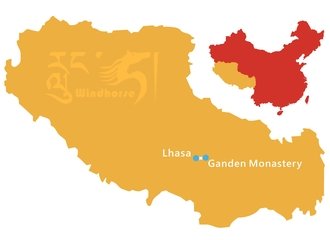Chongqing Hot Pot vs. Chengdu Hot Pot: Which One is the Best

Chinese Hot Pot, known as "huǒguō" in Mandarin, is a beloved culinary tradition deeply ingrained in Chinese culture. This communal dining experience involves a simmering pot of broth placed at the center of the table, surrounded by an array of raw ingredients such as thinly sliced meats, vegetables, seafood, tofu, and noodles. Diners cook the ingredients in the broth and dip them in various sauces, making it a highly interactive and social meal. The origins of hot pot date back over a thousand years, and it has evolved with regional variations that reflect local tastes, ingredients, and cultural influences.
Introduction to Chongqing and Chengdu Hot Pots
Among the numerous regional variations, Chongqing and Chengdu hot pots stand out for their distinctive flavors and rich cultural backgrounds.
Chongqing Hot Pot
Originating from the bustling city of Chongqing, this version is famous for its fiery broth, which is flavored with a generous amount of Sichuan peppercorns, chili, and other spices. The Chongqing hot pot is not just a meal; it's an experience, known for its bold flavors and numbing sensation that sets it apart.
Chengdu Hot Pot
Hailing from the capital of Sichuan Province, Chengdu hot pot is known for its slightly milder but still spicy broth. It often features a variety of broth options, including the iconic "Yuan Yang" pot, which divides the pot into a spicy and a non-spicy side. Chengdu hot pot is a testament to the culinary sophistication of the region, offering a complex blend of flavors and spices.
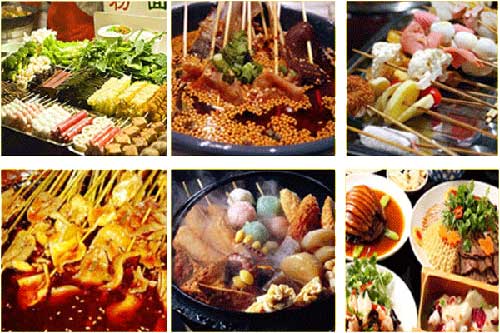
History of the Controversy
Chongqing takes great pride in its invention of hot pot, which is why Chongqing hot pot restaurants often emphasize tradition. Classic Chongqing hot pot features traditional staples, from simple, unpretentious mom-and-pop hot pot restaurants to dishes like "bovine stomach of the boatmen" and "basin hot pot" served in upscale establishments. The authentic, time-honored flavors continue to attract numerous food enthusiasts from near and far.
On the other hand, Chengdu hot pot prefers to come out with innovative ways of eating hot pots and unique combinations of traditional hot pots with other delicious Sichuan dishes. Compared with traditional Chongqing hot pot, Chengdu's essence is that of passionate creativity and fresh new twists.

Ingredients and Preparation
Key Ingredients of Chongqing Hot Pot
Chongqing Hot Pot is renowned for its intense flavors and aromatic spices, creating a unique and memorable dining experience.
Broth Base: The soul of Chongqing hot pot is its broth, known for its numbing spiciness. The base is made from rich stock and a variety of spices including Sichuan peppercorns, dried chili peppers, garlic, ginger, and star anise. A distinct feature is the generous use of beef tallow or vegetable oil, creating a layer of spicy oil on top of the broth that intensifies the flavors.
Meats and Vegetables Commonly Used: The Chongqing hot pot accommodates a wide array of ingredients. Popular meats include thinly sliced beef, lamb, pork, and offal such as beef tripe and duck intestines. Common vegetables include leafy greens, lotus root, mushrooms, and sprouts. Tofu and various types of noodles are also essential accompaniments.
Unique Ingredients or Specialties: Chongqing hot pot is known for including adventurous and bold choices such as goose intestines, pig brain, and duck feet. These ingredients might be unusual to the foreign palate but are cherished for their textures and ability to absorb the spicy broth's flavors.
Key Ingredients of Chengdu Hot Pot
Chengdu Hot Pot is celebrated for its aromatic and complex flavors, offering a slightly different twist from its Chongqing counterpart.
Broth Base: While also spicy, the broth of Chengdu hot pot is often less oily and offers a variety of flavors. Apart from the spicy broth, there's often a choice of mild, non-spicy broths made from chicken, duck, or seafood stock, seasoned with goji berries, jujubes, and other Chinese herbs. The famed "Yuan Yang" pot divides the hot pot into two sections, one spicy and one mild, catering to different preferences.
Meats and Vegetables Commonly Used: Similar to Chongqing hot pot, a wide assortment of meats including chicken, beef, lamb, and various seafood are used. Vegetables like Chinese cabbage, spinach, and mushrooms are popular, as well as starches like sweet potato, taro, and various types of noodles and dumplings.
Unique Ingredients or Specialties: Chengdu hot pot often features unique ingredients that highlight local produce and culinary traditions. Ingredients like duck gizzards, rabbit meat, and local varieties of mushrooms and bamboo shoots are popular. Additionally, a variety of dipping sauces, including sesame oil, garlic, and fermented tofu, complement and contrast the spicy broth.
Both Chongqing and Chengdu hot pots offer a rich tapestry of flavors and ingredients, reflecting the culinary diversity and regional tastes of China. Whether you seek the fiery adventure of Chongqing or the nuanced spice and variety of Chengdu, both experiences promise a delightful and memorable culinary journey.
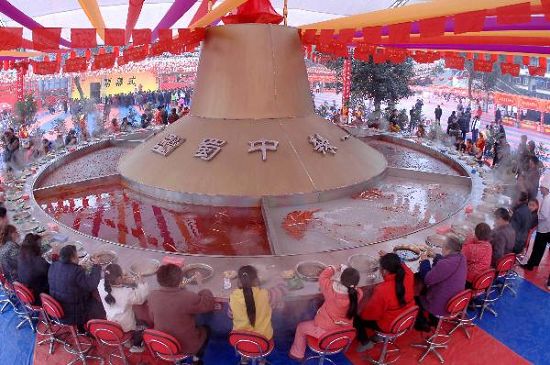
Flavor Profile and Spiciness
Hot pot is a culinary experience where flavor is paramount. The differences in flavor profiles are not solely based on the ingredients but also on the sauce itself. Chongqing hot pot is renowned for its strong flavors, filled with spicy, hot ingredients that create a dense and intense flavor, truly "turning the burn up a notch."
In contrast, Chengdu hot pot sauces emphasize a balance of spice and variety, incorporating five-spice and other aromatic herbs in the pot to make the sauce more fragrant and complex.
Description of Chongqing Hot Pot Flavors
Spiciness Level: Chongqing Hot Pot is notorious for its high spiciness level. The broth is fiery and bold, characterized by a deep red color, indicative of the copious amounts of chili and Sichuan peppercorns used. The unique 'málà' (麻辣) sensation, meaning 'numbing and spicy,' is a hallmark of this hot pot, offering a robust and electrifying eating experience.
Common Spices and Seasonings: The primary spices in the Chongqing hot pot include Sichuan peppercorns, providing the numbing sensation, and various types of dried chilies contributing to the heat. Garlic, ginger, star anise, and bay leaves add depth to the flavor. The use of beef tallow or vegetable oil, infused with these spices, creates a richly flavored and aromatic base. Additional seasonings like black cardamom, cloves, and fennel seeds may also be used to enhance the broth's complexity.
Description of Chengdu Hot Pot Flavors
Spiciness Level: While Chengdu Hot Pot can be quite spicy, it generally offers a broader range of flavors and may not be as intensely spicy as Chongqing Hot Pot. The spiciness is well-balanced with other flavors, offering a more nuanced taste experience. The 'Yuan Yang' pot, in particular, allows diners to enjoy both spicy and mild flavors in one meal.
Common Spices and Seasonings: Chengdu hot pot broth is flavored with spices similar to those in Chongqing hot pot, like Sichuan peppercorns and dried chili. However, it also includes a variety of aromatic ingredients like goji berries, jujubes, cinnamon, and licorice root, especially in the mild broth. These ingredients contribute to a more complex and layered flavor profile, making it aromatic and flavorful without overpowering spiciness.

Comparison of the Flavor Complexity and Uniqueness
Chongqing Hot Pot is celebrated for its bold and straightforward spiciness. The 'málà' flavor dominates, offering an intense and direct heat complemented by rich, aromatic oils. It's a hearty and invigorating choice for those who love an intense, spice-forward dining experience.
Chengdu Hot Pot, on the other hand, is all about balance and variety. The spice level is just one component of a broader spectrum of flavors. The availability of different broths, including the mild options, allows for a more layered and complex eating experience. The variety of dipping sauces and seasonings further adds to the complexity, allowing diners to customize the flavors to their liking.
Eating Experience and Dining Etiquette
Typical Eating Experience with Chongqing Hot Pot
Popular Side Dishes and Condiments: The Chongqing hot pot meal is often complemented by a diverse range of side dishes and condiments. Common side dishes include quail eggs, winter melon, and various types of mushrooms and tofu products. For condiments, diners typically have a personal dipping sauce bowl, which they can customize with ingredients such as minced garlic, chopped green onions, sesame oil, coriander, and a special sauce made from fermented soybeans and sesame paste. The side dishes and condiments are integral to balancing the intense flavors of the hot pot, not just mere add-ons.
Traditional Serving and Eating Practices: In a traditional Chongqing hot pot setting, the pot is placed at the center of the table, with the flame keeping the broth simmering throughout the meal. Diners sit around the pot, cooking the ingredients themselves. It's common to start with the meats, followed by vegetables and other quicker-cooking items. The cooked ingredients are then dipped into personal sauce bowls before eating. Sharing is a central part of the hot pot experience, and the meal is usually enjoyed in a lively, communal atmosphere. The pace is leisurely, with the meal often stretching over several hours, allowing diners to savor the food, engage in conversation, and relish the overall experience.
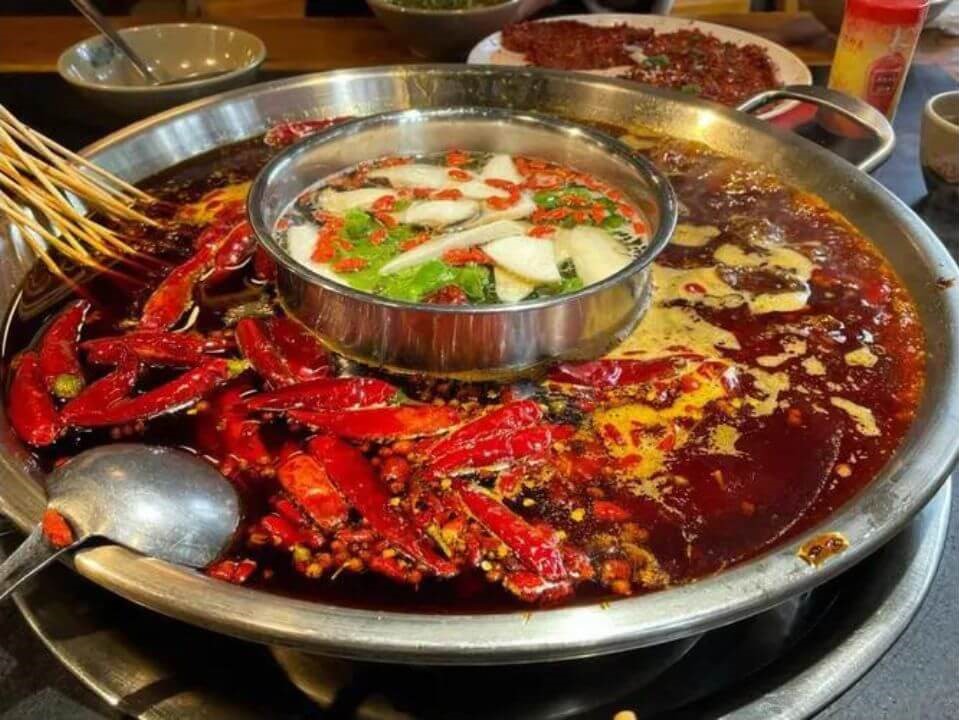
Typical Eating Experience with Chengdu Hot Pot
Popular Side Dishes and Condiments: Chengdu hot pot also offers a variety of side dishes, including fresh vegetables such as leafy greens, lotus root slices, and different types of noodles and dumplings. The condiment selection is extensive, with options like oyster sauce, hoisin sauce, and chili oil available for diners to enhance their dipping sauces. Pickled vegetables and starch-based items like sweet potato slices are also favored for their ability to contrast and complement the spicy broth.
Traditional Serving and Eating Practices: Similar to Chongqing hot pot, Chengdu hot pot is a communal meal, with the pot placed in the middle of the table. However, the 'Yuan Yang' pot, with its divided sections for spicy and mild broth, is a distinctive feature. This allows diners to choose according to their spice tolerance or preference for a specific flavor. The practice of starting with meats and heavier items, moving to vegetables and lighter fare, and customizing individual dipping sauces is also prevalent in Chengdu hot pot dining. The meal is a social event, emphasizing the enjoyment of food and the company of friends and family.
Cultural Significance
As the saying goes, Chongqing people are "straightforward, bold, and unconstrained." The result? The "Dezhuang Big Hot Pot" - a 10-meter (32-foot), 31-ton, Guinness World Record-setting hot pot!
On the other hand, Chengdu people are laid-back and humorous, often preferring to "take the high road" and come up with new hot pot dishes as a form of culinary innovation. Their rebuttal? Dishes with names like "Shameless Fish Hot Pot," "Baldheaded Hot Pot," and "Pigsty Hot Pot"!
The Role of Chongqing Hot Pot in Local Culture
Festivals and Celebrations: In Chongqing, hot pot is not just a meal; it's a cultural emblem. It's common for people to gather around a steaming hot pot during festivals, family reunions, and significant celebrations. During the Chinese New Year and other traditional holidays, hot pot symbolizes the gathering of warmth and unity. It's a time when people set aside their busy lives to sit together, share stories, and enjoy the warmth of both the food and the company.
Symbolic Meanings: Chongqing hot pot holds deep symbolic meaning in local culture. The boiling pot represents the bustling life and fiery spirit of the Chongqing people. The variety of ingredients symbolizes the diversity and richness of life, and the act of sharing the pot signifies unity, harmony, and the communal nature of society. The spiciness of the broth is often seen as a reflection of the locals' bold and resilient nature, facing life's challenges head-on.
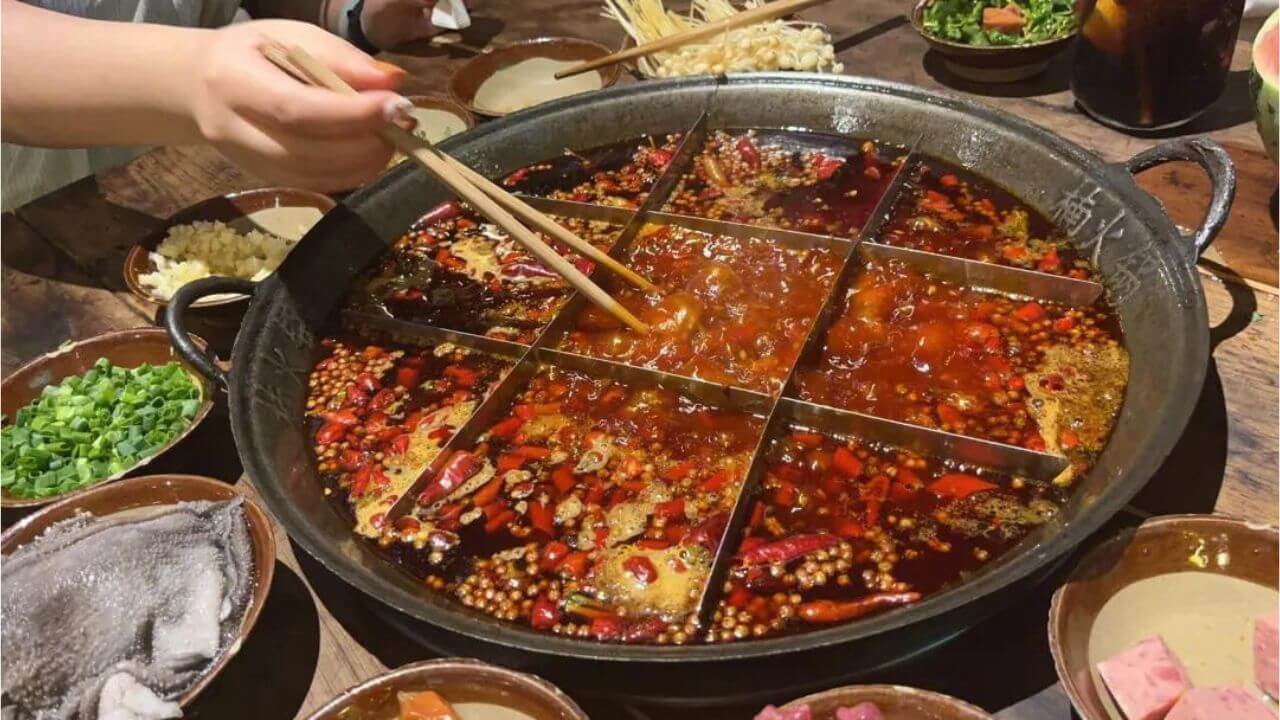
The Role of Chengdu Hot Pot in Local Culture
Festivals and Celebrations: Similar to Chongqing, Chengdu hot pot is a centerpiece in social gatherings and celebrations. It's a popular choice during the Lantern Festival, the Mid-Autumn Festival, and family gatherings. In Chengdu, enjoying hot pot is not just about the food; it's a leisurely activity where people relax, chat, and bond, often stretching for hours into the night.
Symbolic Meanings: The Chengdu hot pot is a symbol of the region's culinary sophistication and the laid-back, yet richly cultured, lifestyle of the people. The balance of flavors in the broth mirrors the philosophical outlook of balance and harmony in life. The variety of ingredients and the option to choose between spicy and mild broths represent the inclusiveness and diversity of the local culture. The shared pot signifies communal values, emphasizing the importance of togetherness and collective enjoyment.
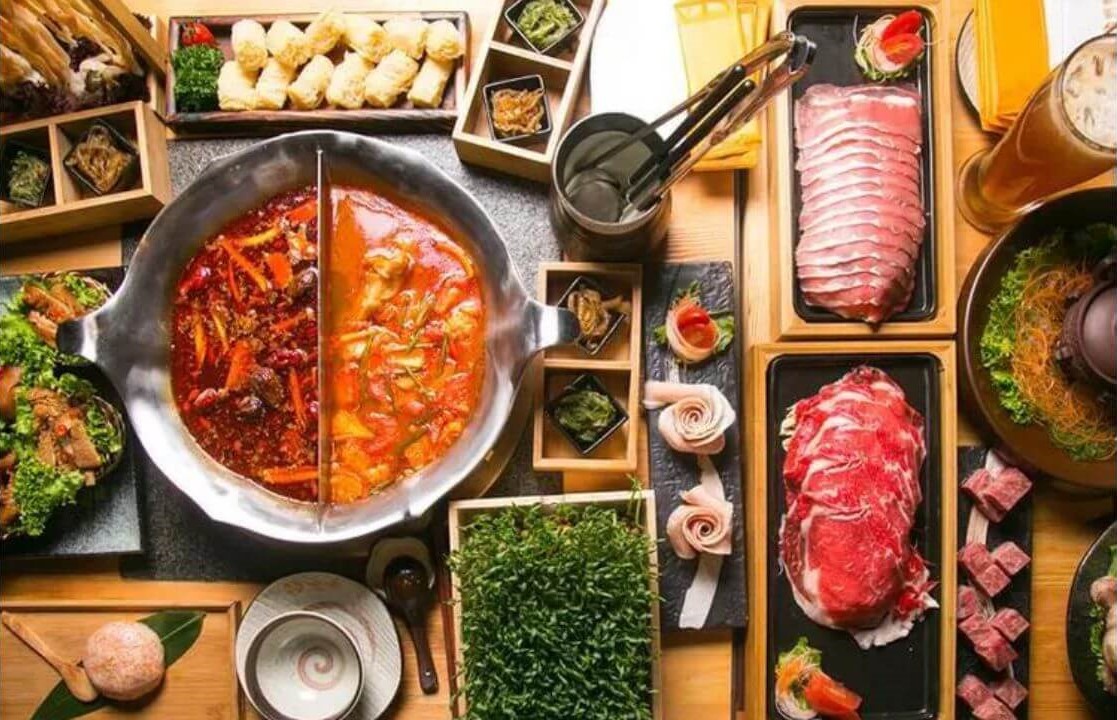
The fierce but friendly competition between Chongqing and Chengdu continues and probably will for years to come. Both styles feature unique characteristics and delicious flavors, but the only way you can decide for sure is to try each for yourself! On your next visit to Chengdu, China, or the Yangtze River Cruise stopover in Chongqing, make sure to treat yourself to these peppery local specialties!


